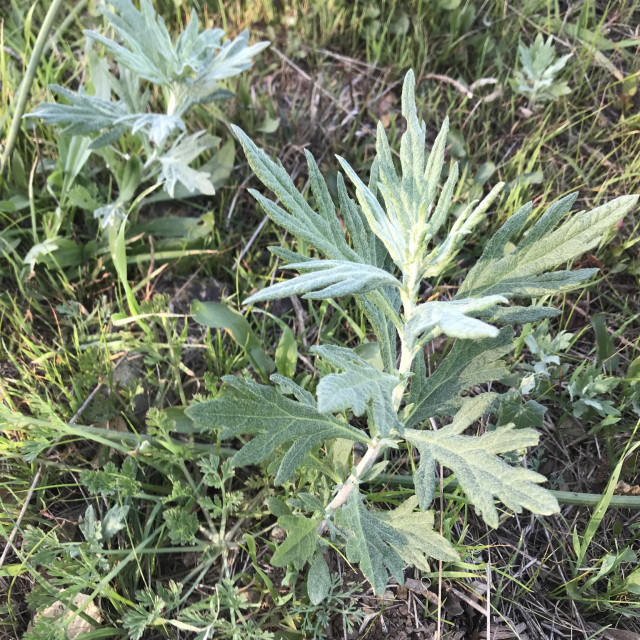COMMON NAME
Mugwort
SCIENTIFIC NAME
Artemisia douglasiana
ALSO KNOWN AS
Douglas' sagewort, Artemisia campestris var. douglasiana, Artemisia vulgaris var. douglasiana
Plant family
Aster (Asteraceae)
Plant group
Wildflowers and Herbs
A stout perennial herb related to sage brush that grows to a height and width of less than a meter (3'). It is distinctive in having a very strong sage-like odor. Its stems can be singular or branched and bear aromatic, gray-green leaves.
110 reports
9+
OBSERVERS
110+
OBSERVATIONS
Identification hints
There are 21 species (and half as many subspecies) of Artemisia in California. Although A. douglasiana can become woody at the base, it remains herbaceous throughout the rest of the plant. This is in contrast to most other sagebrushes which have woody stems. Mugwort usually has lobed leaves which distinguish it from the other common herbaceous sagebrush, A dracunculus or wild tarragon. Mugwort also grows in dense clusters because it spreads with rhizomes which distinguishes it from other species. It also has green to gray-green leaf surfaces, whereas A.suksdorfii has a dark green upper leaf surface. If you are in subalpine to alpine areas, be on the lookout for the similar-looking A. michauxiana, which can be distinguished based on its strong lemon scent.
Did you know?
Mugwort has long been used for aromatherapy by Chumash Indians (and others) to induce dreaming. Typically, the leaves and stems are collected, dried, and then either burned as incense or sewed into small pillows that are then placed under the normal pillow. Mugwort also contains a compound called dehydroleucodine, which appears to prevent formation of lesions in the gastric system. As with many species in the genus Artemisia, Mugwort contains many pleasant-smelling compounds including camphor, linalool, and cineole, as well as some hallucinogenic compounds such as absinthin and thujone (two of the ingredients in absinthe). Mugwort can reproduce sexually (via flowers) as well as asexually (via underground stems called rhizomes that branch from the parent plant). So if you see new shoots coming up in the winter/spring, look for the parent plant nearby.
DISTRIBUTION IN TH U.S.
California
,
Idaho
,
Nevada
,
Oregon
,
Washington
HABITAT
Mugwort is found in many plant communities at lower than 7200 ft (2200 m) elevation. Mugwort is commonly found in chaparral, coastal sage scrub, and oak woodland plant communities, and often within drainages of open to shady areas. It is found throughout most of California (but not in the arid regions of the southeast and northeast). It also occurs north to Washington state and east to Idaho and Nevada.
ATTRIBUTES
Leaves
Leaves are 3"-6" long, evenly spaced along the stem, green to gray-green above and silvery below. They're broader at the base, becoming narrow and pointered toward the tip, often with 3 to 5 pointed lobes. The lobes can be variable on the plant, on some leaves the lobes are seemingly absent, other leaves are very distinctly lobed.
Flowers
The tiny 0.03" (1 mm) wide flowers are either female (pistillate) or male (staminate). The male and female flowers appear within dense clusters known as inflorescences, which contain about 6 to 9 female flowers and about 9 to 25 male flowers. The tiny inflorescences are clustered into small, bell-shaped, nodding heads that are 0.07-0.15" (2 to 4 mm) wide. The flowers are reminiscent of a typical sunflower but smaller and not as showy. Several inflorescences are clustered on a given stem or branch. The flowers appear yellowish when they are dispersing pollen.
Fruits
The tiny fruit is a 1-seeded achene, different from many other sunflower seeds in that it is not hairy and does not have a feathery pappus for wind dispersal.
Bloom Time
The flowers bloom from early summer through the early autumn, generally June to October. The fruits and seeds ripen throughout the summer and autumn.
See Menu
- 2021 Chicago Botanic Garden. All Rights Reserved.
-
Creative Commons
BY-NC-SA 4.0 - Terms of Use
- Privacy Policy
- Data Sharing and Citation Policies
- 2021 Chicago Botanic Garden. All Rights Reserved.



